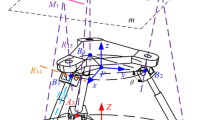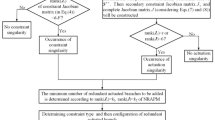Abstract
Based on the prototype of 3-UPU (universal-prismatic-universal joint) parallel mechanism proposed by Tsai [1], the parasitic rotation evaluation is performed and calculated the bound of instability of SNU (Seoul National University) 3-UPU parallel mechanism. Through analysis of the terminal constraint system of the 3-UPU parallel mechanism, the equation about the parasitic rotation and limited clearance is presented. Then the norm of possible parasitic rotation is employed to evaluate the mechanism stability with limited clearance. The higher this number the worst is the pose, the lower it is the best it is. And the contour atlas of parasitic rotation is obtained, which can be used for further analysis and design. With the practice experiment result of SUN 3-UPU parallel mechanism, we find it’s bound of instability, which indicates there will appear the parasitic rotation when the number exceeds the bound. Finally, the method for avoidance of possible parasitic motions is presented by adding redundantly actuated limbs.
Similar content being viewed by others
References
Tsai LW. Kinematics of a three-DOF platform with three extensible limbs. In: Recent Advances in Robot Kinematics, Lenarčič J and Parenti-Castelli V eds. Boston: Kulwer Academic Publishers, 1996, 401–410
Gregorio R D, Parenti-Castelli V. Mobility analysis of the 3-UPU parallel mechanism assembled for a pure translational motion. Journal of Mechanical Design, 2002, 124(2): 259–264
Hervé J M, Sparacino F. Structural synthesis of parallel robots generating spatial translation. In: Proceedings of the Fifth International Conference on Advanced Robotics, 1991, 808–813
Hervé J M. New translational parallel manipulators with extensible parallelograms. In: Proceedings of the 11th World Congress in Mechanism and Machine Science. Tianjin, China, 2004, 1599–1603
Tsai L W. Systematic enumeration of parallel manipulator. In: Proceedings of the 1st European-American Forum on Parallel Kinematic Machines. Milan, Italy, 1998, 1–11
Carricato M, Parenti-Castelli V. A family of 3-DOF translational parallel manipulators. Journal of Mechanical Design, 2003, 125(2): 302–307
Carricato M, Parenti-Castelli V. Singularity-free fully-isotropic translational parallel mechanisms. International Journal of Robotics Research, 2002, 21(2): 161–174
Kong X W, Gosselin C. Type synthesis of 3-DOF translational parallel manipulators based on screw theory. Journal of Mechanical Design, 2004, 126(1): 83–92
Gogu G. Structure Synthesis of Parallel Robots. New York: Springer, 2008
Gogu G. Structural synthesis of fully-isotropic translational parallel robots via theory of linear transformations. European Journal of Mechanics, A, Solids, 2004, 23(6): 1021–1039
Huang Z, Li Q. Type synthesis of symmetrical lower-mobility parallel mechanisms using the constraint-synthesis method. International Journal of Robotics Research, 2003, 22(1): 59–79
Jin Q, Yang T L. Theory for topology synthesis of parallel manipulators and its application to three-dimension-translation parallel manipulators. Journal of Mechanical Design, 2004, 126(4): 625–639
Joshi S A, Tsai L W. Jacobian analysis of limited-DOF parallel manipulator. Journal of Mechanical Design, 2002, 124(2): 254–258
Tsai L W, Joshi S A. Kinematics and optimization of a spatial 3-UPU parallel manipulator. Journal of Mechanical Design, 2000, 122(4): 439–446
Joshi S A, Tsai L W. A comparison study of two 3-DOF parallel manipulators one with three and the other with four supporting legs. IEEE Transactions on Robotics and Automation, 2003, 19(2): 200–209
Guan L W, Wang J S, Wang L P. Mobility analysis of the 3-UPU parallel mechanism based on screw theory. In: Proceedings of the 2004 International Conference on Intelligent Mechatronics and Automation. Chengdu, China, 2004, 309–314
Han C, Kim J, Kim J, Park F C. Kinematic sensitivity analysis of the 3-UPU parallel mechanism. Mechanism and Machine Theory, 2002, 37(8): 787–798
Zlatanov D, Bonev I. Constraint singularity of parallel mechanism. In: Proceedings of the IEEE International Conference on Robotics and Automation. Washington DC, USA, 2002, 496–502
Bonev I, Zlatanov D. The mystery of the singular SNU translational parallel robot. http://www.parallemic.org/Reviews/Review004.html
Zlatanov D, Bonev I, Gosselin C. Constraint singularities as configuration space singularities. In: Advances in Robot Kinematics: Theory and Applications, Lenarčič J and Thomas F eds. Boston: Kluwer Academic Publishers, 2002, 183–192
Wolf A, Shoham M. Investigation of parallel manipulators using linear complex approximation. Journal of Mechanical Design, 2003, 125(3): 564–572
Wolf A, Shoham M. Investigation of singularities and self-motions of the 3-UPU robot. In: Advances in Robot Kinematics: Theory and Applications, Lenarčič J and Thomas F eds. Boston: Kluwer Academic Publishers, 2002, 165–174
Conconi M, Carricato M. A new assessment of singularities of parallel kinematic chains. IEEE Transactions on Robotics and Automation, 2009, 25(4): 757–770
Gogu G. Constraint singularities and the structural parameters of parallel robots. In: Advances in Robot Kinematics: Analysis and Design, Lenarčič J and Wenger P eds. New York: Springer, 2008, 3–12
Chebbi A H, Parenti-Castelli V. Geometric and manufacturing issues of the 3-UPU pure translational manipulator. In: New Trends in Mechanism Science: Analysis and Design, Mechanisms and Machine Science 5. 2010, 595–603
Chebbi A H, Affi Z, Romdhane L. Kinetostatic and singularity analyses of the 3-UPU translational parallel robot. In: Computational Kinematics: Proceedings of the 5th International Workshop on Computational Kinematics. New York: Springer, 2009, 61–68
Merlet J P. Parallel Robot. New York: Springer, 2006
Tsai L W. Robot Analysis: The Mechanics of Serial and Parallel Manipulators. New York: Wiley, 1999
Fang Y F, Tsai L W. Structure synthesis of a class of 4-DoF and 5-DoF parallel manipulators with identical limb structures. International Journal of Robotics Research, 2002, 21(9): 799–810
Kong X W, Gosselin C. Type Synthesis of Parallel Mechanisms. New York: Springer, 2007 219–230
Author information
Authors and Affiliations
Corresponding author
Rights and permissions
About this article
Cite this article
Qu, H., Fang, Y. & Guo, S. Parasitic rotation evaluation and avoidance of 3-UPU parallel mechanism. Front. Mech. Eng. 7, 210–218 (2012). https://doi.org/10.1007/s11465-012-0317-4
Received:
Accepted:
Published:
Issue Date:
DOI: https://doi.org/10.1007/s11465-012-0317-4




